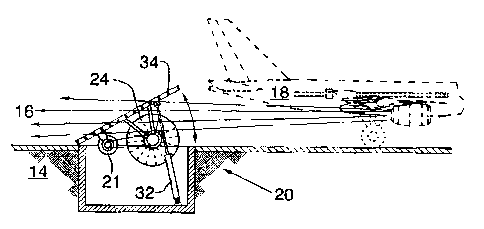Some of the information on this Web page has been provided by external sources. The Government of Canada is not responsible for the accuracy, reliability or currency of the information supplied by external sources. Users wishing to rely upon this information should consult directly with the source of the information. Content provided by external sources is not subject to official languages, privacy and accessibility requirements.
Any discrepancies in the text and image of the Claims and Abstract are due to differing posting times. Text of the Claims and Abstract are posted:
| (12) Patent Application: | (11) CA 2633510 |
|---|---|
| (54) English Title: | JET AIR RECOVERY GENERATOR |
| (54) French Title: | GENERATEUR A RECUPERATION D'AIR D'AVION A REACTION |
| Status: | Deemed Abandoned and Beyond the Period of Reinstatement - Pending Response to Notice of Disregarded Communication |
| (51) International Patent Classification (IPC): |
|
|---|---|
| (72) Inventors : |
|
| (73) Owners : |
|
| (71) Applicants : |
|
| (74) Agent: | |
| (74) Associate agent: | |
| (45) Issued: | |
| (22) Filed Date: | 2008-06-04 |
| (41) Open to Public Inspection: | 2009-12-04 |
| Availability of licence: | N/A |
| Dedicated to the Public: | N/A |
| (25) Language of filing: | English |
| Patent Cooperation Treaty (PCT): | No |
|---|
| (30) Application Priority Data: | None |
|---|
A method of generating energy from a discharge of an aircraft comprising the
steps of:
a) providing an air recovery generator assembly having a bladed wheel; and, b)
positioning
the air recovery generator behind the aircraft. The discharged air from the
aircraft then
turns the wheel thereby generating energy. In a preferred aspect of this
invention the bladed
wheel comprises a bladed cylinder wheel and the bladed cylindrical wheel
additionally rotates
a flywheel to store rotational energy therein. A mechanism is provided to move
the bladed
cylindrical wheel from a below ground storage position to an elevated
operational position.
Note: Claims are shown in the official language in which they were submitted.
Note: Descriptions are shown in the official language in which they were submitted.

2024-08-01:As part of the Next Generation Patents (NGP) transition, the Canadian Patents Database (CPD) now contains a more detailed Event History, which replicates the Event Log of our new back-office solution.
Please note that "Inactive:" events refers to events no longer in use in our new back-office solution.
For a clearer understanding of the status of the application/patent presented on this page, the site Disclaimer , as well as the definitions for Patent , Event History , Maintenance Fee and Payment History should be consulted.
| Description | Date |
|---|---|
| Inactive: IPC expired | 2024-01-01 |
| Inactive: IPC deactivated | 2017-09-16 |
| Inactive: IPC assigned | 2017-01-01 |
| Inactive: IPC expired | 2017-01-01 |
| Inactive: IPC deactivated | 2016-01-16 |
| Inactive: IPC assigned | 2016-01-01 |
| Inactive: First IPC assigned | 2016-01-01 |
| Inactive: IPC expired | 2016-01-01 |
| Time Limit for Reversal Expired | 2013-06-04 |
| Application Not Reinstated by Deadline | 2013-06-04 |
| Inactive: Adhoc Request Documented | 2013-03-06 |
| Deemed Abandoned - Failure to Respond to Maintenance Fee Notice | 2012-06-04 |
| Application Published (Open to Public Inspection) | 2009-12-04 |
| Inactive: Cover page published | 2009-12-03 |
| Inactive: First IPC assigned | 2009-05-13 |
| Inactive: IPC assigned | 2009-05-13 |
| Inactive: IPC assigned | 2009-05-13 |
| Inactive: IPC assigned | 2009-02-17 |
| Inactive: Office letter | 2008-07-15 |
| Application Received - Regular National | 2008-07-10 |
| Filing Requirements Determined Compliant | 2008-07-10 |
| Inactive: Filing certificate - No RFE (English) | 2008-07-10 |
| Small Entity Declaration Determined Compliant | 2008-06-04 |
| Abandonment Date | Reason | Reinstatement Date |
|---|---|---|
| 2012-06-04 |
The last payment was received on 2008-06-04
Note : If the full payment has not been received on or before the date indicated, a further fee may be required which may be one of the following
Please refer to the CIPO Patent Fees web page to see all current fee amounts.
| Fee Type | Anniversary Year | Due Date | Paid Date |
|---|---|---|---|
| MF (application, 2nd anniv.) - small | 02 | 2010-06-04 | 2008-06-04 |
| MF (application, 3rd anniv.) - small | 03 | 2011-06-06 | 2008-06-04 |
| Application fee - small | 2008-06-04 |
Note: Records showing the ownership history in alphabetical order.
| Current Owners on Record |
|---|
| GEORGE A. HENSON |
| Past Owners on Record |
|---|
| None |